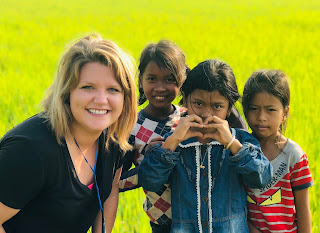Day 12 was a bus tour from Siem Reap to our final destination of Phnom Penn before departing tomorrow. This trip is 350 kilometers (roughly the same distance as it is from Sisseton to Elk Point) and without any stops is over a 5 hour bus trip. The maximum speed limit is 90 km/hr (60 mph). the. Highway was a wide two lane with wide shoulders and would accommodate a faster speed. If all things were equal, but they are not. Heavy bike, scooter and farm equipment traffic, a high accident rate and the fact that drivers treat it like a three lane road and often just go to the empty spot. It has taken some getting used to. Another reason for 90 km/hr is that the minimum age for driving I8, but no official driving school is required and many children still drive below that age.
Sharing the road with others
We visited a Kubota dealership. The dealership is owned by a woman who also owns another store in Siem Reap. She told us that the equipment is imported from Thailand and includes tractors, combines, and backhoes. The group enjoyed seeing the equipment as the dealership mirrored a US facility with the exception of the equipment being much smaller. We were surprised to hear that a rice combine like the one we saw and reported in blog while in Vietnam cost $30,000. Newer and bigger track machines with automated rice baggers run around $70,000. Per one of the sales representatives, most of the dealer financing comes directly from Kubota. Given that productive farm land can run up to $10,000 per acre, the price of the combine did not seem out of line.
Does Jared see himself combining rice?
In between stops our guide Sam Sam our tour guide mentioned the health care system in Cambodia is poor. Most of the time when people are seriously sick they are sent to Thailand or Vietnam. Most people will go to a private clinic when they are sick to be accepted quicker. However, a private clinic is much more expensive. The education system is free. However, many families can’t afford the school uniform and supplies. 40% of high school graduates continue their studies at a university.
School children done with morning classes
Along the way we stopped at an old ancient bridge and to use the “happy room” (an America rest stop). The bridge is over 800 years old and is completely a man made structure. We also ate lunch at a local restaurant. We ate spring rolls, stir fry, fried fish, chicken curry, and French fries.
We stopped at a small farm along the highway that makes pounded rice, similar to what we saw and reported on yesterday. Today’s host ingeniously invented a way to stir the cooking rice, pound the rice and screen the fines out before it becomes a finished product. Some might think it crude but watching and studying it in action, it was a great example of using what’s available to make what is needed.
Farmer’s wife explaining how to make the pounded rice
The machine is powered by a gas engine and belts. Shafts and belts run to the stirring pans in the front, rice pounding hammer by the wife and a rod off of the main engine shaft shakes the rice in the green pan.
Cambodia’s main agricultural exports include rice, cashews, rubber, and black pepper. We saw many of these crops in the afternoon. The landowner we visited owns one hectare that she grows black pepper. This is harvested by hand and her family raises 4 ton of black pepper per year. 1 kilogram of black pepper brings about $6 at the market. We found it interesting that the cost of production is $3,000 per hectare. The bankers in the group enjoyed the fact that she knew her exact cost to help figure out her margins.
Drying pepper
Cashews grow in a larger shell that turns red
New clusters growing
Krysti samples the red cashew cluster. It eats like an apple
Diagonal cuts in the bark of a rubber tree, drain and rubber collector (half of a coconut shell)
Our last stop was to a local market along the highway. Numerous fruits were sold but the group was more interested in the insects, bats, and birds being sold. We all enjoy our fried food, but this selection was something different. Jerry did share a cricket, tarantula legs and part of the body with Sam. When in Rome...
After we arrived to Phnom Penn, we ate supper together at a local restaurant and returned to pack our bags for the trip home.
We all had a great trip and learned an incredible amount about Vietnam and Cambodia. We are blessed to live in a great country with so many wonderful benefits. Our challenge to ourselves is how we take what we have learned, develop it for application in our lives and return home to make South Dakota a better place. The global view and how we can best work with our world partners is vital to the legacy we will leave behind. We are looking forward to our trip home tomorrow. We have missed American food and our day to day lives, but most importantly we have missed our families and loved ones.
Thank you for taking the time to read the blog. We hope you enjoyed our pictures and stories. A special thanks to Jerry Cope for putting all of this together each day.
Matt Lindgren, reporter; Sam Olson and Ellie Haerter, photographers
Matt Lindgren, reporter; Sam Olson and Ellie Haerter, photographers























































